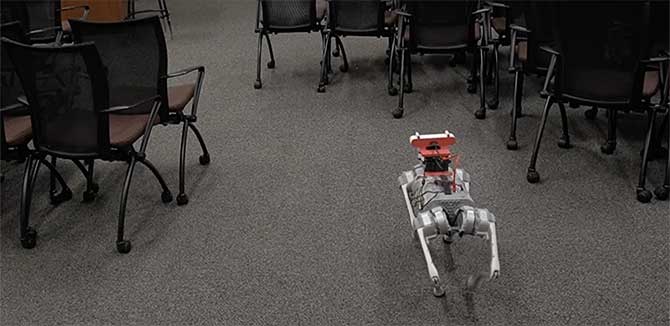Creating a Search-and-Rescue Robot Dog
Aditya Nair's independent MSR project was inspired by a hiker's 700-foot fall and could be the beginnings of a search-and-rescue robotic dog to find lost or injured hikers.

Amelia Milling was hiking along the Crow Creek trail in Alaska when she fell 700 feet down a mountain. She survived, but only because a dog found her.
Milling was about four miles into a hike through Chugach State Park when she fell 300 feet, collided with a boulder, and plummeted another 400 feet. The dog, trained to help lost hikers find their way back to a trail, stayed by her side and helped her get to safety.
Milling's story was covered by national media, and Aditya Nair (MSR ‘24) was fascinated by the hiker's story. He wondered if a robot dog could be trained to do the same thing.
For his independent project for Northwestern Engineering's Master of Science in Robotics (MSR) program, Nair created a search-and-rescue robot dog to help future hikers who are lost or hurt in the wilderness.
It was a project he would not have known how to pursue prior to his time in the MSR program.
“Six months before the MSR program, it would not really be possible for me to do it,” he said. “But speaking to people over here and finding out about new cameras that are available really made it feel doable.”
For 10 weeks, Nair worked under the guidance of MSR co-director Matthew Elwin to train the robot dog, named Oatmeal, to autonomously navigate in open space, on unlevel ground, and around obstacles to find a lost or hurt subject.
Nair used a Unitree Go1 robot dog, a ZED 2i camera, and a Nvidia Jetson Orin Nano developer kit for the project. He relied on simultaneous localization and mapping (SLAM) for object detection and used the robot operating system (ROS) to integrate a number of different sensors and computers. He also used a 3D-printed mount to fix the developer kit to the dog.
Nair got the robot to explore and locate a lost subject in a small indoor environment, but was not able to deploy it in a sparse outdoor environment. While the robot did not explore autonomously the way he originally wanted, Nair acknowledged the goal was too ambitious for the project's 10 week timeline.
To get Oatmeal to succeed in a truly open wilderness environment would take years, not weeks. Still, Nair was proud of what he accomplished and the advances he made toward building a true search-and-rescue robot dog.
The project also brought Nair closer to his career goals. Nair talked in internship interviews about how he planned the Oatmeal project, managed so many integrations, and overcame obstacles on the way to success. allowed him to talk in internship interviews about overcoming obstacles to find success.
Nair is spending the summer interning with HEBI robotics in Pittsburgh, where he is applying the integration skills he used to build Oatmeal on a variety of products the company is moving closer to market.
“I specifically emphasized that I have been able to do these things in a short span of time and I've been able to adapt to hurdles that I didn't see before,” he said. “That was one of the major reasons I was able to get an internship.”

